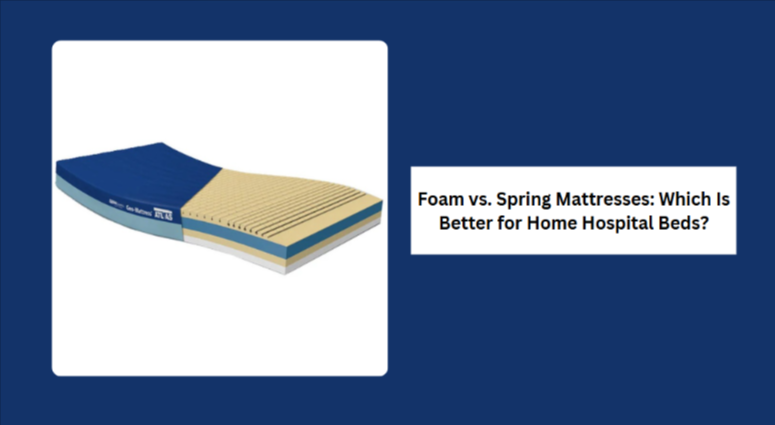When setting up a hospital bed at home, choosing the right mattress is one of the most important decisions you’ll make. Comfort, pressure relief, durability, and support all play a crucial role in a patient’s recovery and daily well-being. While there are several mattress types available, the two most common options are foam mattresses and spring mattresses.
So, which one is better for hospital beds for home? In this article, we’ll compare foam vs. spring mattresses, their pros and cons, and which one best supports home-based medical care.
Why Mattress Choice Matters for Hospital Beds at Home
Home hospital beds are designed to support individuals who spend extended periods lying down—whether due to surgery, aging, injury, or chronic illness. A standard mattress just won’t cut it. You need something that not only fits the bed frame but also offers:
- Pressure relief to prevent sores
- Adaptability to bed adjustments (head/leg elevation)
- Support for varying weights and medical conditions
- Comfort for long durations
Let’s dive into how foam mattresses and spring mattresses perform in these areas.
What Is a Foam Mattress?
A foam mattress is made from multiple layers of synthetic foam, such as memory foam, polyurethane, or gel-infused foam. These layers conform to the body’s shape, offering customized support and comfort.
✅ Pros of Foam Mattresses:
- Pressure Relief: Great for reducing stress on pressure points—ideal for immobile patients.
- Body Contouring: Adapts to different body shapes and sleeping positions.
- Low Motion Transfer: Ideal if someone shares the bed or moves a lot.
- Flexible: Easily adjusts with motorized hospital bed settings.
❌ Cons of Foam Mattresses:
- Heat Retention: Some foams trap heat unless they have cooling gel.
- Can Feel Too Soft: Not ideal for users needing firm support without sagging.
What Is a Spring Mattress?
A spring mattress, also known as an innerspring mattress, contains a system of metal coils that offer bounce and support. These mattresses often have a comfort layer made of foam or padding on top of the coils.
✅ Pros of Spring Mattresses:
- Firm Support: Especially useful for heavier users or those who prefer less sink-in feeling.
- Airflow: Coils allow better ventilation and cooler sleep.
- Familiar Feel: Mimics traditional home mattresses.
❌ Cons of Spring Mattresses:
- Poor Pressure Distribution: Can cause discomfort over time, especially for patients who don’t move much.
- Less Adaptability: Doesn’t flex easily with adjustable hospital beds.
- Can Cause Noise: Springs can become noisy or lose support with wear.
Foam vs. Spring: Key Comparison for Home Hospital Beds
| Feature | Foam Mattress | Spring Mattress |
| Pressure Relief | Excellent for reducing bedsores | Moderate – uneven in some positions |
| Compatibility with Bed Adjustments | Very good – conforms easily | Limited – may not bend comfortably |
| Comfort for Long-Term Use | Ideal for prolonged lying down | May cause soreness over time |
| Heat Regulation | Can retain heat (unless gel-infused) | Better airflow and cooler sleep |
| Durability | High with dense foams | Moderate – coils may wear or sag |
| Maintenance | Lightweight and easy to handle | Heavier and harder to flip or move |
| Price Range | Wide range – budget to premium | Typically mid-range to budget options |
Which Is Better for Hospital Beds for Home?
✅ Foam Mattress: Best for Medical Needs and Long-Term Comfort
If you’re setting up a hospital bed for home use and caring for someone who will spend several hours—or even full days—in bed, a foam mattress is often the superior choice. Here’s why:
- It helps prevent pressure ulcers, a common risk for bedridden patients.
- It works seamlessly with adjustable bed frames.
- It’s available in medical-grade versions specifically designed for hospital use.
The best foam mattress will offer a balance of firmness, support, and contouring, and can even include cooling technology or layers of gel for added comfort.
🟡 Spring Mattress: Suitable for Short-Term Use or Budget Setups
A spring mattress can still work for hospital beds if the patient is more mobile, will be using the bed for shorter periods, or prefers a firmer sleep surface. However, it’s not ideal for those who are immobile or have high risk of pressure injuries.
If you go with a spring mattress, consider adding a foam or gel topper to improve pressure relief and adaptability.
What to Look for in the Best Foam Mattress for Hospital Beds
When choosing a foam mattress for a hospital bed, keep the following in mind:
- High-Density Foam: Offers better support and durability over time.
- Cooling Features: Look for gel-infused or breathable foam to prevent overheating.
- Waterproof Cover: Makes cleaning easy and prevents damage from spills.
- Certifications: Ensure the foam is safe, non-toxic, and suitable for medical use (CertiPUR-US® certified).
- Size Compatibility: Most hospital beds are 36” x 80”, but always check your bed frame.
Don’t Forget the Bed Frame
Remember, no mattress performs well if it’s not paired with the right bed. A quality hospital bed offers electric adjustments, safety rails, and a frame built for caregiving convenience.
Pairing the best foam mattress with a sturdy, adjustable hospital bed for home use ensures your loved one receives the best care and comfort—right where they belong.
Final Thoughts
The right mattress can significantly impact recovery, comfort, and overall health. While spring mattresses might be suitable for short-term or active patients, foam mattresses provide the support, flexibility, and pressure relief needed for home-based care and long-term comfort.
If you’re investing in a hospital bed for home, make sure to complete the setup with a reliable, medically suitable foam mattress. Your loved one deserves a surface that promotes rest, recovery, and dignity every single day.
